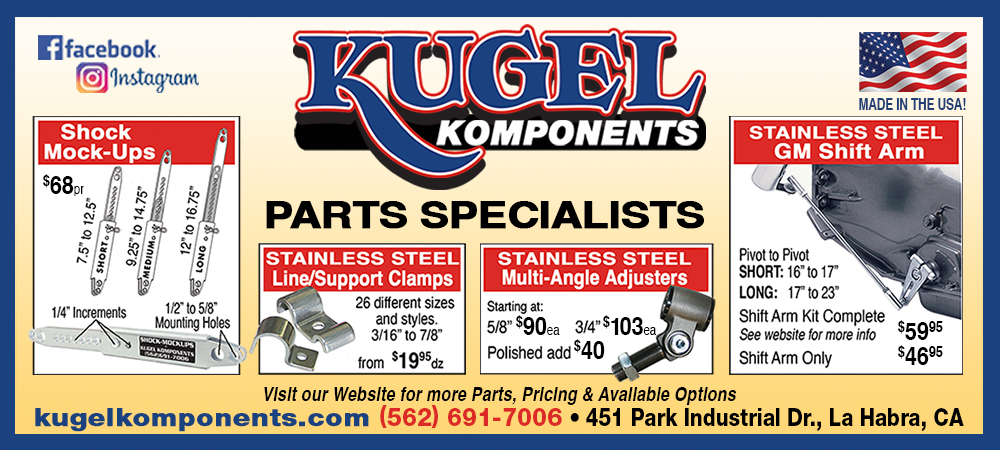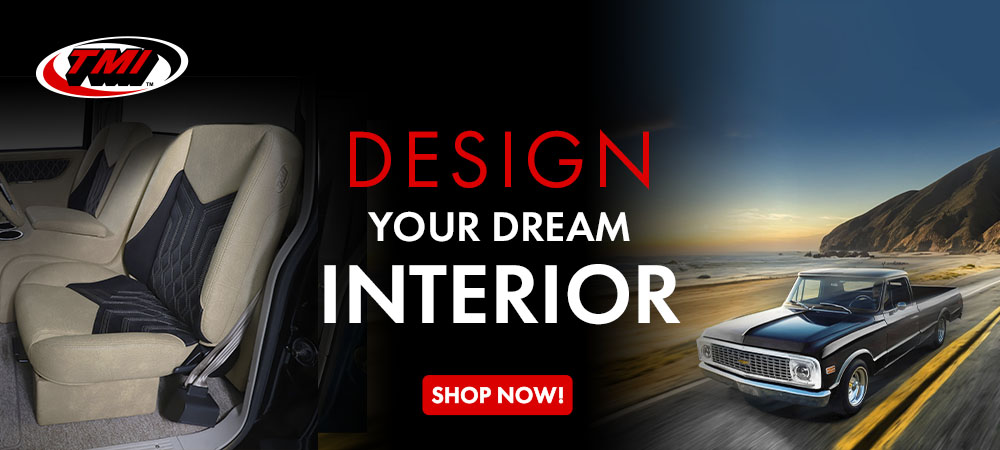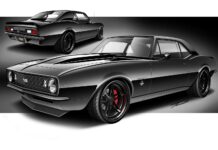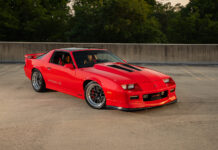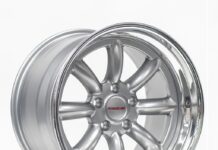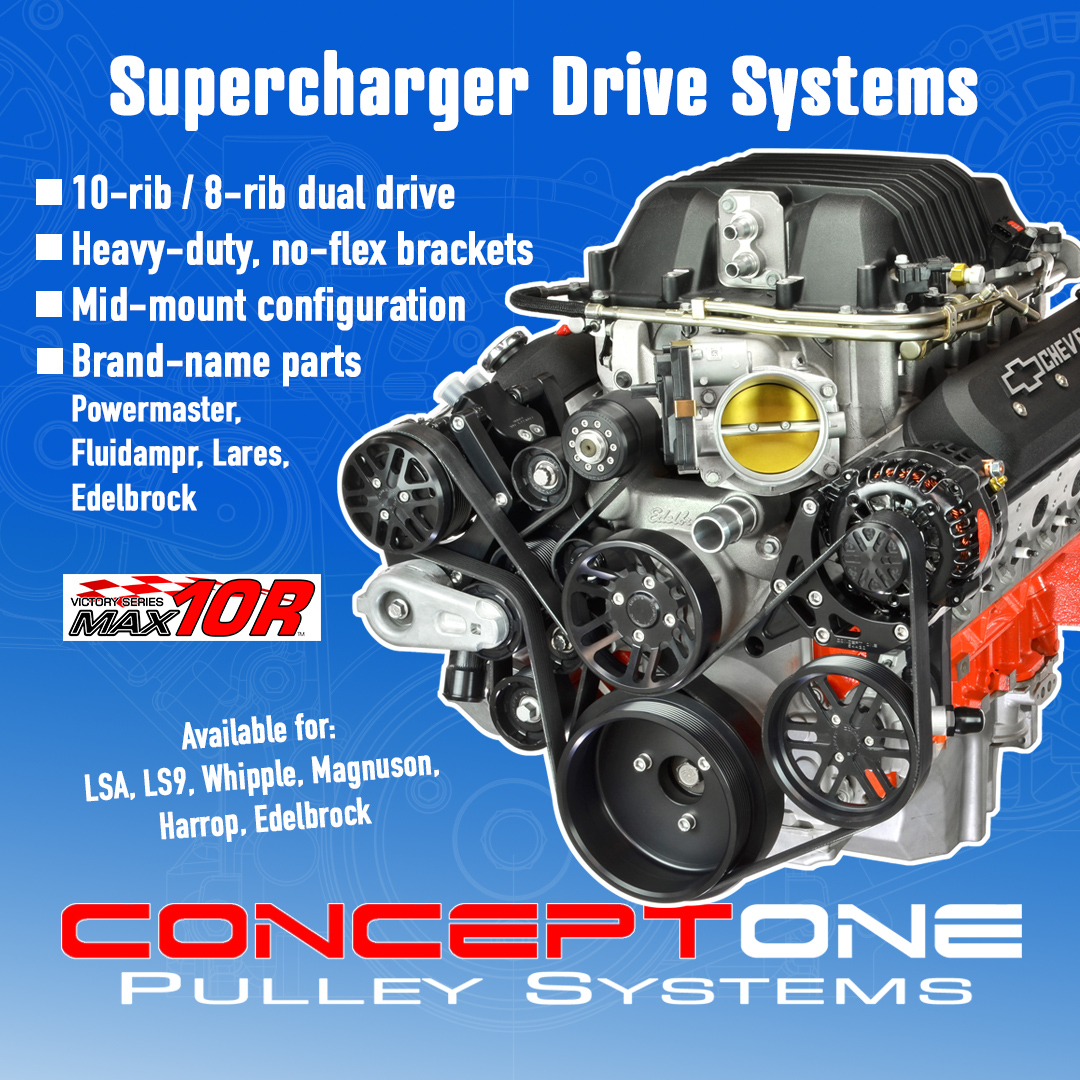By Tommy Lee Byrd – Photography by the Author
If you’ve ever wondered where the term “Funny Car” came from, it may become apparent with one glance at this wildly altered Chevelle drag car. The odd proportions were the result of moving the rear axle forward to achieve better weight transfer, but the reality is that these funky-looking creations didn’t last long before the one-piece fiberglass flip-top bodies became the norm. The name Funny Car stuck, even though the floppers of the late ’60s had much better proportions. But for a brief time in 1965 and 1966 the cars were wild, and they literally got wilder with every week that passed. This meticulously restored drag car is one of the founding fathers of Funny Cars, as it is the world’s first tube chassis, center steer, full-bodied drag car. This car’s restoration and careful attention to detail allows us to hit the pause button on the rapidly evolving world of A/FX match racing and Funny Cars, pinpointing a three-month window when the “Tiger II” Chevelle ran in this configuration.
To get things started, let’s go back to the delivery of this ’65 Chevelle 300 two-door sedan. Yes, we said ’65. This car was delivered to Plains Chevrolet in Amarillo, Texas, as a rolling chassis. No VIN was assigned, no money was exchanged—this was meant to be a race car from day one and there is no paper trail to determine how this arrangement came about. Jimmy Adcock worked the deal, and he already had an excellent sponsorship with Esso, which used the slogan “Put a Tiger in Your Tank” for advertising. This sponsorship led to the building of “Tiger,” a high-end Sprint Car, and, ultimately, the “Tiger II,” this outstanding Chevelle.
STAYING TRUE: Bob Updike’s ’70 Chevelle
Early in 1965, the car was assembled using a flat fiberglass hood and fenders. It was such a new car that Fibercraft had not yet manufactured a fiberglass front end, so they used a ’64 front end instead. A straight front axle and Pontiac rear axle were added to the original chassis, and an Enderle-injected small-block Chevy engine was installed. The stroked small-block came in at 376 ci and ran on a 30 percent load of nitromethane even before the wheelbase was altered.
For the Tiger II Chevelle, 1965 was a year of constant change, going from a stock car to an altered wheelbase match racer in a matter of months, but big plans were already brewing for the 1966 season. During the off season, Adcock commissioned T-Bar Chassis Company to build a custom tube chassis for the Chevelle. T-Bar was a popular choice for dragster and altered frames, but this was the first time a purpose-built Funny Car chassis was on the table. The car rolled out of the shop in early 1966 with a drastically different setup, now weighing in at only 1,600 pounds. The body had been completely gutted and fit with fiberglass doors and a fiberglass decklid to go along with the other fiberglass components. The gold metalflake paint and Tiger II lettering remained, but the car was a whole new animal. Adcock kept a busy schedule of match races at tracks like Albuquerque Dragway, Amarillo Dragway, and many others in Texas and Oklahoma. The car was known for its wheelstands, and even filled in for purpose-built wheelstanders on occasion.
Once again, changes happened quickly, as the wheelbase was moved around several times and various tricks were implemented to aid in traction. The T-Bar chassis has mounts for leaf springs, and it also ran several different trailing arm setups with coil springs.
Read More: Steve Hofferber’s Pro Street 1970 Chevelle
Midway through the 1966 season, a Hilborn-injected 427ci big-block running on a heavy load of nitromethane entered the equation. The first notation of the 427 power is a flyer for a match race in September 1966 and it is believed that the car ran in this configuration until the offseason. So, for three months, the car had a nitro-injected 427 and the Tiger II paintjob. Around this time is also when the B-pillars were removed, and the magnesium spindle mount wheels were added to the front for even more weight savings. The big-block configuration was estimated at only 1,800 pounds and the car ran a best of 9.08 at 165 mph in this configuration.
Changes happened again in 1967, as the Esso sponsorship ended. The car got yet another new identity. This time, a color change was in order, going from gold metalflake to blue with the name “Blitzer” on the side. By 1967, the flip-top Funny Cars began their campaign, immediately sending the early altered wheelbase cars into lesser classes like B/Altered or into the scrap pile. In an effort to keep up with the big guys, Adcock installed a blown and injected big-block Chevy, but the combination was banned by the NHRA and he sold the engine to Dave McClelland. From there, Adcock sold the car, and it is unknown who bought it, but we do know that it landed in Alabama a few years later. J.C. Sizemore bought it and ran it as a match race companion to his famous altered wheelbase “Golden Rod” ’55 Chevy match racer. The car was last raced in 1973 by Jerry Rhodes and renamed “Funny Money.”
So, how did Dave Giles, a hot rodder and drag racer from East Tennessee, run across this car? It was 2005, and a coworker brought in a clipping from an automotive trader newspaper that had a photo of vintage racing wheels and a short description. Dave called the number and headed to Alabama the next morning with a pocket full of cash and hopes of scoring some Halibrands. As he made his selections, he found a pair of early style magnesium spindle-mount Americans, so he asked the owner, “Where’s the rest of the Funny Car?” To his surprise, the fellow knew where it was and actually took him there. It was a bumpy process but Dave ultimately bought the rotted hulk of a car and brought it back to Tennessee, not knowing its history or its significance.
Read More: 1965 Chevelle Has Lived its Life on the Streets of New York City
After Dave began uncovering its lineage, he dove headfirst into a full restoration. With so many configurations in such a short amount of time, it was hard to choose a time period to replicate, but he decided on the late-’66 configuration. He relied on the support of his wife, Stephani, and daughter, Faith, as well as numerous friends throughout the restoration process. His obsessive level of research and detail led to a highly accurate restoration, although he did make a few changes to prepare the car for exhibition passes. The engine is built for nitromethane and is estimated at 1,200 hp on 80 percent.
Amazingly, Dave was able to salvage many of the original parts during the restoration. The only fiberglass component that he had to replace was the hood. Many hours were spent on the body to bring it back to life and Jesse Welch at Trickpaint & Custom applied the custom-mixed metalflake and also did the hand lettering. Of course, Dave restored and installed those original spindle-mount wheels that started this whole process and went with black steel wheels and vintage M&H 820-15 slicks out back. The interior is sparce, but that’s how it was in 1966.
Dave put the finishing touches on the car in the fall of 2023, but he still loves to research its history and imagine what it must’ve been like to experience the fast-paced world of Funny Car racing in the mid ’60s. His Chevelle is a founding father of Funny Cars, and it deserved every ounce of effort he poured into it.
TECH CHECK:
Owner: Dave and Stephani Giles, Knoxville, Tennessee
Vehicle: 1965 Chevelle 300
Engine:
Type: Big-block
Displacement: Originally 427 ci now 439 ci
Compression Ratio: 13.5:1
Bore: 4.310 inches
Stroke: 3.76 inches
Rotating Assembly: Velasco billet crank, MGP rods, Wiseco pistons
Cylinder Heads: Dart Iron Eagle, mildly ported
Valvetrain: Manley valves, Comp rocker arms
Camshaft: Comp Cams solid roller
Intake: Hilborn mechanical fuel injection, Alkydigger components
Ignition: Don Zig Vertex magneto
Assembly: Randy Bradford
Exhaust: Doug’s Headers
Output: Estimated 1,200 hp on 80 percent nitromethane
Drivetrain:
Transmission: Ultimate Turbo 400 by Mike’s Transmission
Torque Converter: Hughes 2,500 rpm
Rear Axle: Pontiac, Mark Williams spool, Fabcraft axles, 3.64:1 gears
Chassis:
Front Suspension: Straight axle with leaf springs
Rear Suspension: Custom trailing arms with QA1 coilovers
Brakes: Pontiac drums (rear only)
Pedals: Moon gas pedal, custom brake pedal
Wheels & Tires:
Front Wheels: Magnesium American Racing TorqThrust 15×4 spindle-mount
Front Tires: Goodyear Power Streak 560-15
Rear Wheels: Wheelsmith OE 15×7
Rear Tires: M&H Racemaster 820-15 slicks
Interior:
Seats: Fibercraft fiberglass racing bucket
Steering: Superior
Shifter: Hurst
Dash: Stock with aluminum inserts
Instrumentation: Sun tach, Stewart-Warner oil pressure gauge
Exterior:
Bodywork: Trickpaint & Customs (Wenatchee, WA)
Paint: House of Kolor gold metalflake with silver base
Hood: Fiberglass
Grille: ’64 Chevelle
Bumpers: Fibercraft Fiberglass
Door Handles: Stock
Trunk: Fibercraft Fiberglass
Lights: Headlights removed
Click on this issue’s cover to see the enhanced digital version of Dave Giles Restores “Tiger II,” the Founding Father of Funny Cars.













